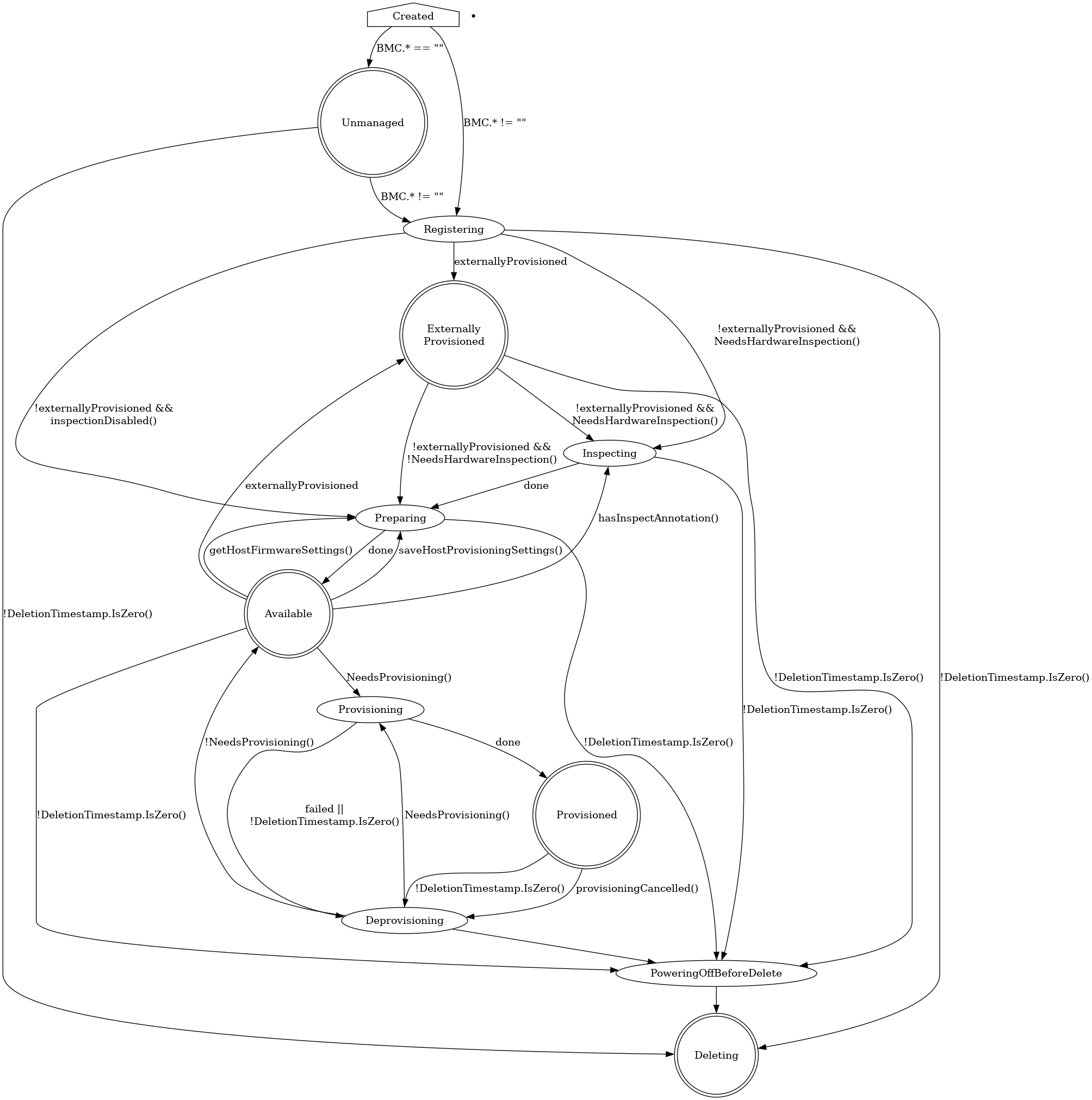Host State Machine
During its lifetime, a BareMetalHost resource goes through a series of
various states. Some of them are stable (the host stays in them indefinitely
without user input), some are transient (the state will change once a certain
operation completes). These fields in the status resource define the current
state of the host:
status.provisioning.state– the current phase of the provisioning process.status.operationHistory– the history of the main provisioning phases: registration, inspection, provisioning and deprovisioning.status.operationalStatus– the overall status of the host.status.errorType– the type of the current error (if any).status.poweredOn– the current power state of the host.
This is how the status of a healthy provisioned host may look like:
status:
# ...
operationHistory:
deprovision:
end: null
start: null
inspect:
end: "2024-06-17T13:09:07Z"
start: "2024-06-17T13:03:54Z"
provision:
end: "2024-06-17T13:11:18Z"
start: "2024-06-17T13:09:26Z"
register:
end: "2024-06-17T13:03:54Z"
start: "2024-06-17T12:54:18Z"
operationalStatus: OK
poweredOn: true
provisioning:
ID: e09032ea-1b7d-4c50-bfcd-b94ff7e8d431
bootMode: UEFI
image:
checksumType: sha256
checksum: http://192.168.0.150/SHA256SUMS
format: qcow2
url: http://192.168.0.150/jammy-server-cloudimg-amd64.img
rootDeviceHints:
deviceName: /dev/sda
state: provisioned
# ...
OperationalStatus
OK– the host is healthy and operational.discovered– the host is known to Metal3 but lacks the required information for the normal operation (usually, the BMC credentials).error– error has occurred, see thestatus.errorTypeandstatus.errorMessagefields for details.delayed– cannot proceed with the provisioning because the maximum number of the hosts in the given state has been reached.detached– the host is detached, no provisioning actions are possible (see detached annotation for details).
Provisioning state machine

Provisioning states
Creating
Newly created hosts get an empty provisioning state briefly before moving
either to unmanaged or registering.
Unmanaged
An unmanaged host is missing both the BMC address and credentials
secret name, and does not have any information to access the BMC
for registration.
The corresponding operational status is discovered.
Externally Provisioned
An externally provisioned host has been deployed
using another tool. Hosts reach this state when they are created with the
externallyProvisioned field set to true. Hosts in this state are monitored,
and only their power status is managed.
Registering
The host will stay in the registering state while the BMC access details are
being validated.
Inspecting
After the host is registered, an IPA ramdisk will be booted on it. The agent
collects information about the available hardware components and sends it back
to Metal3. The host will stay in the inspecting state until this process is
completed.
Preparing
When setting up RAID or changing firmware settings, the host will be in
preparing state.
Available
A host in the available state is ready to be provisioned. It will move to the
provisioning state once the image field is populated.
Provisioning
While an image is being copied to the host, and the host is configured
to run the image, the host will be in the provisioning state.
Provisioned
After an image is copied to the host and the host is running the
image, it will be in the provisioned state.
Deprovisioning
When the previously provisioned image is being removed from the host,
it will be in the deprovisioning state.
Powering off before delete
When the host that is not currently unmanaged is marked to be deleted, it
will be powered off first and will stay in the powering off before delete
until it’s done or until the retry limit is reached.
Deleting
When the host is marked to be deleted and has been successfully powered off, it
will move from its current state to deleting, at which point the resource
record is deleted.